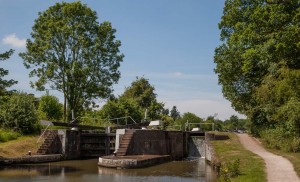
Lock 34 as it normally appears (from the south)
From 19 January to 14 February 2015 maintenance work has been carried out by CRT on Lock 34 of the Hatton flight of 21 Locks.
This section of the Grand Union Canal stretches for 2 miles and is one of the most impressive sights on the network. The top lock is set in rural surroundings from where the canal descends through the locks with the distant vision of Warwick Cathedral, viewed along the canal, growing in the distance.
Having parked the car at Bridge 54 my wife and had a chance meeting with Richard Parry (CEO of the CRT) who had already visited Lock 34.
After lunching on a hot, locally baked, Focaccia stuffed very generously with chicken, bacon and cheese at the splendid cafe (highly recommended) near top lock we walked down to lock 34 some 1500 yards and 12 locks away.
There was a regular flow of sightseers along the way taking the 10 minute walk down to the lock.
At the lock we were greeted by a number of CRT staff and volunteers who were only too eager to answer questions. With very little waiting we were given a conducted tour (a dozen at a time) by CRT man Ian Darby down into the empty lock.
The maintenance work was almost complete and I was surprise to see the good condition of the brickwork walls, base and gates which were last replaced in 2004.
Below is a narrated photo gallery and slideshow of the tour.
To view photos:
1. View a larger version of a single image in a separate page – Right Click on the image then Left Click on “Open link in new tab” or “Open link in new window”.
Or…
2. Display an enlarged gallery – Left Click on an image – use the large side arrows to move between images – Left Click outside an image or press ESC to close the enlarged gallery.

Approaching Lock 34 from the north.

A combined team of CRT staff and volunteers were on hand to enrich the experience for visitors.

A group of visitors having things explained in the drained lock.

Looking north the cill, maintained top gates and planks holding back the water.

Descending into the bowels of the lock was easier than expected.

CRT man Ian Darby described the scene and the structures in the lock.

Our group down in the lock.

Closer view of a top gate.

Heavily laden boats would plough into the cills damaging the stonework as shown, so protective wooden buffers were secured to them by metal bolts.

Ian explained that when drained the walls were layered with mud which when removed surprisingly left the remains of insect larvae.

Close up of insect larvae.

To lessen the fury of incoming water when the lock is filling, long chambers funnel the flow to several large outlets on each side wall.

Escape ladders were badly corroded.

Ladders brickwork recesses checked and made sound.

Surprisingly few foreign objects found when drained – mostly shells of foreign invasive mussel.

Mussel shells.

A bottom gate installed in 2004 and still sound and sturdy.

Shown is one of two exit paddles for emptying the lock chamber in normal use.

Beyond the lower gates are the outlets from the two exit paddles – beyond are planks holding back the water from the bottom pound.

A bottom gate showing the damage caused by boaters pushing the gates open with the bow of their boat.

This is a hinge sunk into the base of the lock and the bottom of the gate.

The hinge is simplicity itself but works for many years.

View over the lock from the south.

View south from the lock.
























